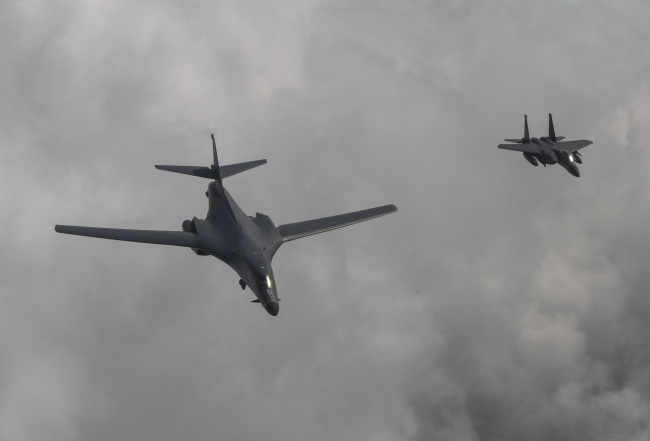Tensions rise as US, NK trade barbs following B-1B flyover
By Sohn Ji-youngPublished : July 30, 2017 - 15:40
Tension is running high on the Korean Peninsula following North Korea’s second launch of an intercontinental ballistic missile, with the US sending strategic bombers in a show of force and Pyongyang warning Washington against its pressure on the regime.
After taking off from Anderson Air Base in Guam, B-1B Lancers joined four South Korean F-15k fighter jets to conduct interception and formation training, and left the peninsula later in the day after finishing their 10-hour mission, according to the allies’ militaries.
The deployment came as a “direct response” to North Korea, which conducted two ICBM tests this month. The latest missile fired Friday is thought to be capable of reaching the West Coast of the US, a milestone that Washington had long declared it would not tolerate.
“North Korea remains the most urgent threat to regional stability,” said Gen. Terrence J. O’Shaughnessy, the US Pacific Air Forces commander. “If called upon, we are ready to respond with rapid, lethal and overwhelming force at a time and place of our choosing.”
Gen. Won In-chul, commander of South Korean Air Force Operations Command, echoed the remark, saying the South Korean military maintains the capability to “completely and accurately” destroy Pyongyang’s missile sites and leadership compounds.

Hours after the bombers left the peninsula, North Korea denounced the US for engaging in “military adventurism,” warning of the possibility that the communist country would conduct another provocation.
"If the United States sticks to its military adventurism against us and super-intensive sanctions schemes, we will respond with stern action of justice as we have already declared," the North's state-run Korean Central News Agency said.
Armed with precision-guided bombs capable of hitting North Korea’s underground wartime commands, the bombers were also deployed on July 8, four days after North launched its first-ever ICBM. Unlike the previous deployment, the bombers reportedly did not conduct a live-fire exercise this time.
The flyover appears to be the first package of US deployment of strategic assets following the North’s second ICBM launch. Hours after the liftoff, Defense Minister Song Young-moo said South Korea would deploy strategic US military assets, although he did specify their types and the deployment schedule.
“Among the pre-planned flight operation in the event of North Korea’s ballistic missile launch, (Sunday’s deployment of) B-1Bs was the fastest one,” a military official said under the condition of anonymity due to the sensitivity of the issue
The scope and scale of US reinforcement is expected to be enhanced around next month when the allies prepare for the upcoming Ulchi Freedom Guardian exercise scheduled to take place in late August. On the list are nuclear-powered aircraft carriers, submarines and stealth fighters, such as F-22 Raptors
Such a measure is expected to unnerve North Korea, which has long denounced the allies’ annual exercise as an invasion attempt. When two B-1B were deployed earlier this month, the North compared it to “playing with fires on a powder keg.”
Among the options the North might consider, an analyst said, is the launch of an upgraded version of a submarine-launched ballistic missile or Pukguksong-3, the latest variant of solid-fueled ballistic missiles, which were presumed to be enclosed in a canister during the North’s military parade on April 15.
Citing a US defense official, CNN reported that the North conducted a missile ejection test Tuesday at a naval shipyard in Sinpo, South Hamkyong Province, where North Korea is thought to have repositioned submarines and barges used for an SLBM test in August last year.
“We assess that North Korea has continued its activity to develop an SLBM. We have continued to monitor relevant activities,” Col. Roh Jae-chun, spokesperson of South Korea’s Joint Chiefs of Staff, said at a regular press briefing Thursday.
Some analysts warned of the possibility that the North would conduct a sixth nuclear test. According to a report from Japanese Nihon Keizai Shimbun, North Korea is “more likely than before” to conduct the nuclear test to enhance its leverage ahead of a potential negotiation with the US.
By Yeo Jun-suk (jasonyeo@heraldcorp.com)








![[KH Explains] Hyundai's full hybrid edge to pay off amid slow transition to pure EVs](http://res.heraldm.com/phpwas/restmb_idxmake.php?idx=644&simg=/content/image/2024/04/18/20240418050645_0.jpg&u=20240419100350)






![[From the Scene] Monks, Buddhists hail return of remains of Buddhas](http://res.heraldm.com/phpwas/restmb_idxmake.php?idx=652&simg=/content/image/2024/04/19/20240419050617_0.jpg&u=20240419175937)

![[KH Explains] Hyundai's full hybrid edge to pay off amid slow transition to pure EVs](http://res.heraldm.com/phpwas/restmb_idxmake.php?idx=652&simg=/content/image/2024/04/18/20240418050645_0.jpg&u=20240419100350)

![[Today’s K-pop] Illit drops debut single remix](http://res.heraldm.com/phpwas/restmb_idxmake.php?idx=642&simg=/content/image/2024/04/19/20240419050612_0.jpg&u=)